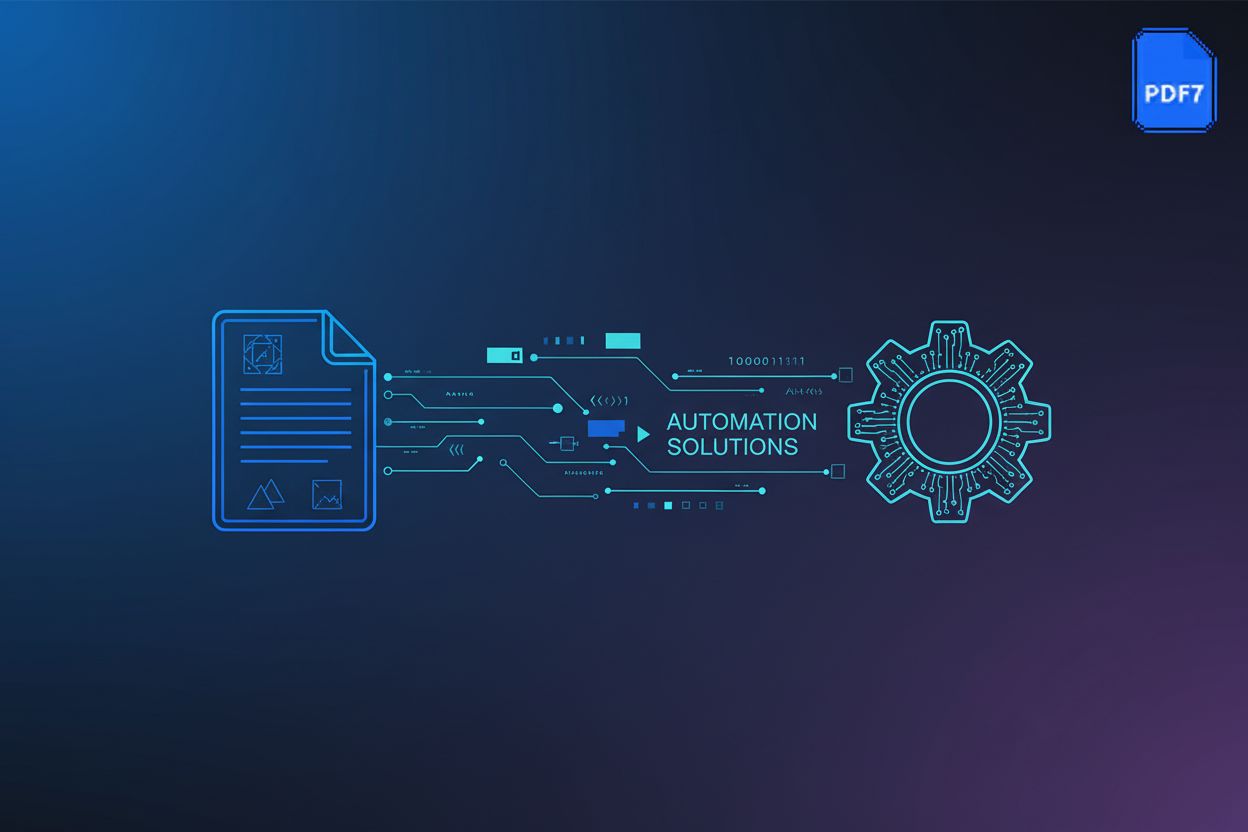Unlocking Efficiency: Serverless PDF Processing Architectures
Introduction to Serverless PDF Processing
Imagine a world where processing hundreds, or even thousands, of PDF documents is as simple as flipping a switch. That's the promise of serverless PDF processing.
Serverless architecture is a cloud computing model where the provider manages the infrastructure, allowing developers to focus solely on writing and deploying code. It primarily revolves around two key concepts: Function as a Service (FaaS) and Backend as a Service (BaaS). FaaS allows developers to execute code in response to events without managing servers, while BaaS provides pre-built backend services like authentication and databases. According to an AWS Whitepaper, serverless computing reduces operational overhead and accelerates development cycles.
"Serverless uses managed services where the cloud provider handles infrastructure management tasks like capacity provisioning and patching."
Key characteristics include:
- No server management: Developers don't need to provision or maintain servers.
- Automatic scaling: The platform automatically scales resources based on demand.
- Pay-per-use billing: You only pay for the compute time your code consumes.
Serverless architectures are particularly well-suited for PDF processing due to their inherent scalability and cost-efficiency. This approach allows businesses to handle fluctuating workloads without manual intervention.
- Scalability: Serverless functions can automatically scale to handle varying workloads, from a few documents to thousands.
- Cost efficiency: You only pay for the actual compute time used during PDF processing tasks, eliminating the costs associated with idle servers.
- Reduced complexity: Developers can focus on the core PDF processing logic rather than infrastructure management.
- Event-driven processing: Workflows can be triggered by file uploads or other events, creating automated pipelines.
Serverless PDF processing can be applied to a wide range of tasks across various industries.
- Document conversion: Converting PDFs to other formats like Word, Excel, or images, is a common requirement.
- PDF manipulation: Tasks such as merging, splitting, rotating, and organizing PDF pages can be easily automated using serverless functions.
- Content extraction: Extracting text, images, and metadata from PDFs is crucial for data analysis and archiving.
- Security: Protecting PDFs with passwords, watermarks, and encryption ensures sensitive information remains secure.
- Optimization: Compressing PDF files for smaller size and faster loading improves user experience and reduces storage costs.
As we delve deeper, we'll explore specific architectures and tools that make serverless PDF processing a reality.
Core Components of a Serverless PDF Processing Architecture
Did you know the average enterprise uses over 1,900 cloud applications? To leverage serverless PDF processing, it's crucial to understand its core components. Let's break down the essential elements that make this architecture tick.
FaaS platforms are the backbone of serverless architectures. They allow developers to execute code in response to events without managing servers.
- AWS Lambda, Azure Functions, and Google Cloud Functions are popular choices. Each offers unique features.
- Choosing the right platform depends on factors like language support, pricing models, and integration capabilities. For example, if your team is heavily invested in .NET, Azure Functions might be a natural fit.
- It's also essential to be aware of function execution limits, memory allocation, and concurrency settings. These parameters can impact performance and cost.
Event triggers initiate PDF processing workflows. They connect external events to serverless functions.
- S3 bucket triggers are a common pattern. Uploading a PDF to an S3 bucket automatically triggers a processing function. For instance, a healthcare provider could automatically process patient forms uploaded to a secure S3 bucket.
- API Gateway exposes PDF processing functions as REST APIs. This enables applications to programmatically interact with your PDF processing capabilities.
- Message queues (like SQS or Kafka) decouple processing tasks for asynchronous workflows. A retail company might use this to queue and process thousands of product catalogs without overwhelming the system.
- Scheduled events (using CloudWatch Events) trigger batch processing of PDFs at regular intervals. A financial institution could use this to process monthly statements overnight.
The 'PDF Processing Logic' within the FaaS platform is where the actual PDF manipulation happens. This typically involves custom code written in languages like Python, Node.js, or Java, utilizing specific libraries. For example, you might use libraries like PyPDF2 or ReportLab in Python for tasks like merging, splitting, or adding watermarks, or Tika or PDFMiner for text extraction. For image conversion, libraries like ImageMagick or Ghostscript are often employed.
Storage solutions are critical for storing both input and output PDF files. They also handle temporary storage needs during processing.
- Object storage (like S3, Azure Blob Storage, or Google Cloud Storage) is ideal for storing input and output PDF files. These services offer scalability, durability, and cost-effectiveness.
- Temporary storage, such as the
/tmpdirectory within Lambda functions, is useful for temporary file processing. However, be mindful of storage limits. - Database integration allows you to store metadata and processing results in databases like DynamoDB or RDS. For example, a law firm might store extracted text and metadata from legal documents in DynamoDB for easy searching.
As you design your serverless PDF processing architecture, understanding these core components is essential. Next, we'll explore the specific tools and libraries that enable PDF manipulation within serverless functions.
Designing Serverless PDF Processing Workflows
Serverless PDF processing workflows can be as unique as the documents they handle. But what do these workflows actually look like in practice? Let's explore some common examples.
To start, consider a scenario where you need to generate thumbnails from a batch of PDF documents. A typical workflow would involve:
- Trigger: A PDF file is uploaded to an S3 bucket.
- Function: An AWS Lambda function is triggered. This function converts the PDF to JPG or PNG images using libraries like ImageMagick or Ghostscript.
- Output: The generated images are stored in another S3 bucket, ready for use in a web application or content management system.
Next, let's look at a situation where you need to extract text from a large number of PDF invoices for data analysis.
- Trigger: An API Gateway endpoint receives a PDF file via a REST API call.
- Function: A Lambda function is invoked, extracting text from the PDF using libraries like PDFMiner or Tika.
- Output: The extracted text is returned as a JSON payload or stored in a database for further processing. Organizations should consider how to handle complex layouts and OCR requirements for scanned documents. For scanned documents, you might integrate with cloud-based OCR services or use libraries that support OCR, though this can add complexity and cost.
For more complex workflows, consider using AWS Step Functions (or similar orchestration services). These services allow you to visually define workflows, handle errors, and manage state.
- Benefits: Visual workflow definition, built-in error handling, and simplified state management.
- Example: A workflow that converts a PDF to an image, extracts text from the same PDF, and then stores the extracted text and image metadata in a database.
- AWS Step functions enable you to build more agile applications so you can innovate and respond to change faster. Understanding serverless architectures - Optimizing Enterprise Economics with Serverless Architectures
These examples show just a few of the ways you can design serverless PDF processing workflows. Next up, we'll dive into the specific tools and libraries that make these workflows possible.
Implementing Security and Optimization
Is your serverless PDF processing architecture a fortress or a sieve? Implementing robust security and optimization strategies is crucial to protect your data and maximize efficiency.
Security in serverless architectures requires a multi-layered approach. Here are key strategies to safeguard your PDF processing workflows:
- IAM roles: Restrict function permissions to access only necessary resources. For instance, a function that only extracts text from PDFs shouldn't have permission to modify S3 buckets.
- VPC configuration: Isolate functions within a private network. This prevents direct internet access and reduces the attack surface.
- Data encryption: Encrypt PDF files both at rest (e.g., in S3 buckets) and in transit (e.g., using HTTPS). This ensures confidentiality even if unauthorized access occurs.
- Input validation: Prevent malicious PDF files from causing security vulnerabilities. Validate file headers, sizes, and content to avoid exploits. For example, within your serverless function, you could use a library to check the PDF file's magic bytes to ensure it's a valid PDF, and also check its size against a reasonable limit before proceeding with processing.
Even the most secure system can be inefficient if not optimized. Here's how to fine-tune your serverless PDF processing functions:
- Memory allocation: Allocate sufficient memory to avoid timeouts. Experiment to find the optimal balance between performance and cost, as over-allocation can increase expenses.
- Code optimization: Minimize function execution time by optimizing code and dependencies. Use efficient algorithms and remove unnecessary libraries.
- Concurrency limits: Understand and manage function concurrency to prevent throttling. Monitor function invocations and adjust concurrency limits as needed.
- Caching: Cache frequently accessed data to reduce processing time. For example, cache OCR results for commonly processed document templates.
Serverless doesn't automatically mean cheap. Let's explore some cost-saving strategies:
- Right-sizing functions: Optimize memory allocation to reduce costs. As mentioned earlier, allocating too much memory increases expenses without necessarily improving performance.
- Reducing function duration: Minimize execution time through code optimization. Shorter execution times directly translate to lower costs.
- Leveraging reserved concurrency: Reserve concurrency for critical workflows. This ensures consistent performance and avoids unexpected throttling. You can typically configure reserved concurrency within your FaaS platform's settings, guaranteeing a certain number of concurrent executions for a specific function.
- Monitoring and usage analysis: Track function invocations and costs to identify optimization opportunities. Use CloudWatch or similar tools to pinpoint areas for improvement.
By implementing these security and optimization techniques, you can create a serverless PDF processing architecture that is not only efficient and cost-effective but also robust and secure. Next, we'll explore the vital role of monitoring and logging in maintaining a healthy serverless environment.
Use Cases and Real-World Examples
Serverless PDF processing isn't just theoretical; it's transforming how businesses operate daily. Let’s explore some concrete use cases where this technology shines.
First off, consider how organizations can automatically convert and index documents uploaded to a document management system. For example, a large legal firm might use serverless functions to convert scanned documents into searchable PDFs, making case files more accessible. Serverless architectures also enable the extraction of metadata for improved search and organization. A healthcare provider can automatically extract patient names, dates of birth, and medical record numbers from PDF forms for easier retrieval. Applying security policies to protect sensitive documents is another key application. A financial institution could automatically encrypt PDF statements before storing them, ensuring compliance with data protection regulations.
In the realm of e-commerce and retail, generating PDF invoices and receipts for customer orders is a common task. An e-commerce platform can use serverless functions to create and send branded invoices to customers immediately after a purchase. E-commerce businesses can also convert product catalogs to PDF format for easy downloading. Retail companies could offer downloadable catalogs for offline browsing, enhancing customer experience. Serverless PDF processing can automatically watermark PDF documents to prevent unauthorized distribution. A digital publisher might watermark e-books to protect their intellectual property.
Finally, let's look at data analysis and automation. Serverless functions can extract data from PDF reports and integrate it into data warehouses. A market research firm could automatically extract survey data from PDF reports and load it into a data warehouse for analysis. Automation of financial statements and legal documents processing becomes seamless with serverless. A global investment bank can automate the processing of quarterly financial reports, ensuring accuracy and efficiency. Converting scanned documents to searchable PDFs using OCR (Optical Character Recognition) is another valuable use case. Government agencies can convert archives of scanned documents into searchable PDFs, improving public access to information.
These examples highlight the flexibility and power of serverless PDF processing across various industries. Next, we'll delve into monitoring and logging, crucial for maintaining a healthy serverless environment.
Leveraging PDF7 for Serverless PDF Solutions
Serverless PDF processing can be even more efficient by leveraging specialized online tools. How can you simplify PDF tasks and enhance your serverless workflows without complex coding?
PDF7 is a versatile online PDF tool designed for conversion, compression, and editing. It offers a user-friendly interface and a range of functionalities that can be easily integrated into serverless architectures. PDF7's capabilities can be incorporated within your serverless workflows through api calls, allowing for automated PDF processing without the need for local installations or complex configurations. This streamlines the development process and reduces operational overhead. You can easily convert PDFs to various formats such as Word, Excel, JPG, and PNG without requiring any downloads. This is particularly useful in scenarios where you need to transform PDF data for different applications or platforms. Automate tasks like merging, rotating, and organizing PDFs for efficient workflows. For example, a document management system could automatically merge multiple PDF reports into a single document for archiving purposes.
PDF7 allows you to convert PDF files to various formats and compress them for smaller sizes. This is valuable for optimizing storage costs and improving the speed of document delivery. For instance, an e-commerce company could compress product catalogs to reduce bandwidth usage. With PDF7, you can effortlessly merge, rotate, remove pages, and organize PDFs. This is useful for preparing documents for different purposes, such as creating customized training materials or assembling legal documents. Protect and unlock PDFs with passwords and permissions, ensuring sensitive documents remains secure. A financial institution could use this to secure statements before sending them to customers. PDF7 includes tools for paraphrasing, translation, summarization, and grammar checking. These can be used to enhance document accessibility and ensure clarity. For example, a global marketing firm could use the translation tool to adapt marketing materials for different regions.
Enhance your serverless PDF processing architecture with PDF7's capabilities, making document management smoother and more efficient. Head over to https://pdf7.app/ to discover how PDF7 can elevate your document workflows with its user-friendly online tools.
By integrating tools like PDF7, you can significantly enhance your serverless PDF processing capabilities. Next, we'll discuss the critical aspect of monitoring and logging in serverless environments.
Conclusion: The Future of PDF Processing is Serverless
Serverless PDF processing is no longer a futuristic concept; it's a present-day solution that's reshaping industries! What does the future hold for this transformative technology?
Serverless architectures offer scalability, cost efficiency, and reduced complexity for PDF processing. Workflow design is crucial. Tailor components to meet specific needs, ensuring seamless integration. Security and optimization are essential for reliable and cost-effective processing.
We're seeing increased adoption of serverless PDF processing across industries, from healthcare to finance. Expect more ai and machine learning integration for advanced document analysis, extracting deeper insights. And of course, improved tooling and frameworks for easier building and deployment of serverless solutions.
So, experiment with serverless PDF processing today. Unlock new levels of efficiency. Explore the resources and tools discussed in this article to enhance your workflows. And hey, share your experiences with the community. Contribute to its growth.
The serverless future is here, and it's transforming PDF processing.








